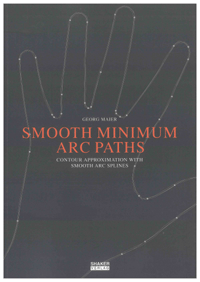
Catalogus : Recensies
Recensies

|
Georg Maier Smooth Minimum Arc Paths Contour Approximation with Smooth Arc Splines ISBN: 978-3-8322-9554-7 Prijs: 49,80 € / 99,60 SFR |
|---|---|
| The book is related to two domains, more precisely, to the frontier between computer aided design and approximation theory. The goal of the subject presented is to give a representation of the contour for a quasi-planar object by a planar (smooth) curve approximating the extracted point. This solution is presented as better than the solution given by a finite list of pixel coordinates which constitute the information from the border of an object captured by an optical sensor. The appropriate description of the contour is an important matter in practical domains related to subjects is vision metrology and quality assurance. One approach is to approximate the contour with smooth arc splines (composed with circular arcs and line segments which are linked at the break points by some smoothness conditions). This kind of approach can be viewed as a multi-criterial optimization among can be underlined the minimization of the approximation error which can be obtained by taking an increased number of pieces (arcs and segments) in the structure of the estimator. In order to solve this problem the author defines a start-destination channel having a source and a destination segment. Taking into account this approach, every smooth minimum arc path which is an arc spline being preserved inside the start-destination channel and connecting the source and destination segments with a minimum number of segments is an appropriate solution of the problem. More exactly, if we consider a start and an end point on a piecewise restricted analytic curve (particularly a polygon), the solution will be a smooth arc path composed by a minimum number of pieces, smoothly connected in the break points and preserved in the inside of the curve closure. The author presents a mathematical characterization of this kind of solution based on an algorithm of order equal to the square of the number of vertices. The book is structured in six chapters, having also a useful index of symbols, algorithms, notions and references based on both classical and recent works in the _eld. In the introductory chapter, the motivation of the work is given beginning with some practical example from reverse engineering. In the second chapter, basic de_nitions and notations are prepared, namely conics and circles, planar curves and arc splines, together with some results related to set-valued analysis and approximation theory, Hausdor_ metric and local Hausdor_ topology. The mathematical modeling for the outlined problem is presented in the third chapter, the algorithmic approach is the goal for the fourth chapter and various applications of minimum arc paths are described in the fifth chapter. Also, some open problems and possible future research directions are outlined in the last chapter. The book is well written taking into account both theoretical and practical issues. Nicoleta Breaz (Alba Iulia) | |
| Bron: Zentralblatt MATH 1216 | 1 | |
| verder naar publicatie ... | |